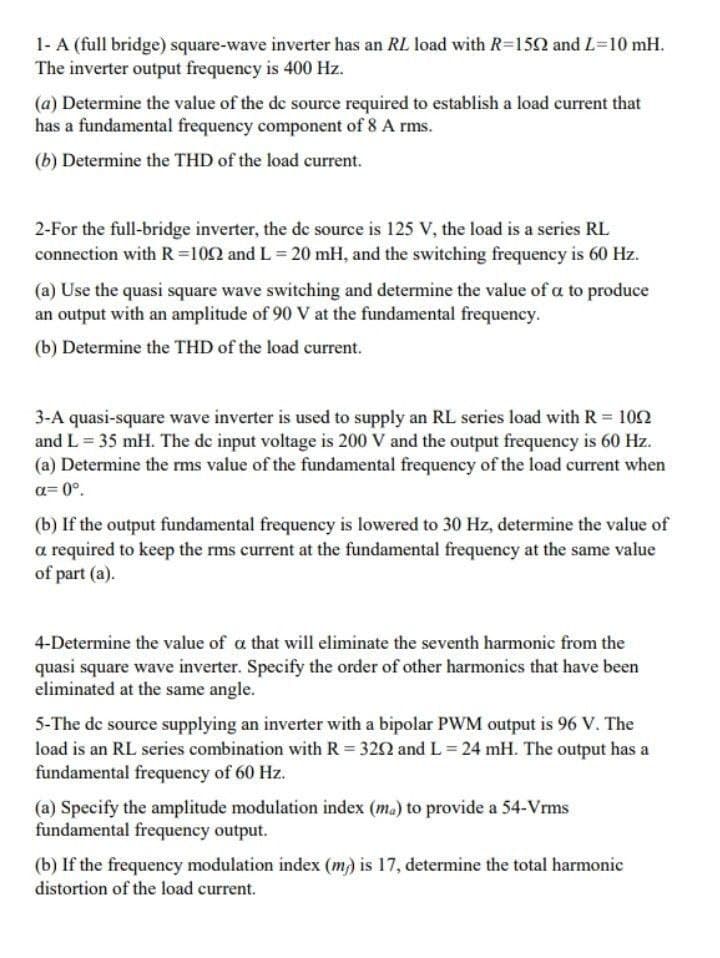1- A (full bridge) square-wave inverter has an RL load with R=150 and L=10 mH. The inverter output frequency is 400 Hz. (a) Determine the value of the de source required to establish a load current that has a fundamental frequency component of 8 A rms. (b) Determine the THD of the load current.
1- A (full bridge) square-wave inverter has an RL load with R=150 and L=10 mH. The inverter output frequency is 400 Hz. (a) Determine the value of the de source required to establish a load current that has a fundamental frequency component of 8 A rms. (b) Determine the THD of the load current.
Introductory Circuit Analysis (13th Edition)
13th Edition
ISBN:9780133923605
Author:Robert L. Boylestad
Publisher:Robert L. Boylestad
Chapter1: Introduction
Section: Chapter Questions
Problem 1P: Visit your local library (at school or home) and describe the extent to which it provides literature...
Related questions
Concept explainers
KVL and KCL
KVL stands for Kirchhoff voltage law. KVL states that the total voltage drops around the loop in any closed electric circuit is equal to the sum of total voltage drop in the same closed loop.
Sign Convention
Science and technology incorporate some ideas and techniques of their own to understand a system skilfully and easily. These techniques are called conventions. For example: Sign conventions of mirrors are used to understand the phenomenon of reflection and refraction in an easier way.
Question
None

Transcribed Image Text:1- A (full bridge) square-wave inverter has an RL load with R=152 and L=10 mH.
The inverter output frequency is 400 Hz.
(a) Determine the value of the de source required to establish a load current that
has a fundamental frequency component of 8 A rms.
(b) Determine the THD of the load current.
2-For the full-bridge inverter, the de source is 125 V, the load is a series RL
connection with R 102 and L = 20 mH, and the switching frequency is 60 Hz.
(a) Use the quasi square wave switching and determine the value of a to produce
an output with an amplitude of 90 V at the fundamental frequency.
(b) Determine the THD of the load current.
3-A quasi-square wave inverter is used to supply an RL series load with R = 10N
and L = 35 mH. The de input voltage is 200 V and the output frequency is 60 Hz.
(a) Determine the rms value of the fundamental frequency of the load current when
a= 0°.
(b) If the output fundamental frequency is lowered to 30 Hz, determine the value of
a required to keep the rms current at the fundamental frequency at the same value
of part (a).
4-Determine the value of a that will eliminate the seventh harmonic from the
quasi square wave inverter. Specify the order of other harmonics that have been
eliminated at the same angle.
5-The de source supplying an inverter with a bipolar PWM output is 96 V. The
load is an RL series combination with R = 320 and L = 24 mH. The output has a
fundamental frequency of 60 Hz.
(a) Specify the amplitude modulation index (ma) to provide a 54-Vrms
fundamental frequency output.
(b) If the frequency modulation index (m) is 17, determine the total harmonic
distortion of the load current.
Expert Solution
This question has been solved!
Explore an expertly crafted, step-by-step solution for a thorough understanding of key concepts.
This is a popular solution!
Trending now
This is a popular solution!
Step by step
Solved in 2 steps

Knowledge Booster
Learn more about
Need a deep-dive on the concept behind this application? Look no further. Learn more about this topic, electrical-engineering and related others by exploring similar questions and additional content below.Recommended textbooks for you

Introductory Circuit Analysis (13th Edition)
Electrical Engineering
ISBN:
9780133923605
Author:
Robert L. Boylestad
Publisher:
PEARSON

Delmar's Standard Textbook Of Electricity
Electrical Engineering
ISBN:
9781337900348
Author:
Stephen L. Herman
Publisher:
Cengage Learning

Programmable Logic Controllers
Electrical Engineering
ISBN:
9780073373843
Author:
Frank D. Petruzella
Publisher:
McGraw-Hill Education

Introductory Circuit Analysis (13th Edition)
Electrical Engineering
ISBN:
9780133923605
Author:
Robert L. Boylestad
Publisher:
PEARSON

Delmar's Standard Textbook Of Electricity
Electrical Engineering
ISBN:
9781337900348
Author:
Stephen L. Herman
Publisher:
Cengage Learning

Programmable Logic Controllers
Electrical Engineering
ISBN:
9780073373843
Author:
Frank D. Petruzella
Publisher:
McGraw-Hill Education

Fundamentals of Electric Circuits
Electrical Engineering
ISBN:
9780078028229
Author:
Charles K Alexander, Matthew Sadiku
Publisher:
McGraw-Hill Education

Electric Circuits. (11th Edition)
Electrical Engineering
ISBN:
9780134746968
Author:
James W. Nilsson, Susan Riedel
Publisher:
PEARSON

Engineering Electromagnetics
Electrical Engineering
ISBN:
9780078028151
Author:
Hayt, William H. (william Hart), Jr, BUCK, John A.
Publisher:
Mcgraw-hill Education,